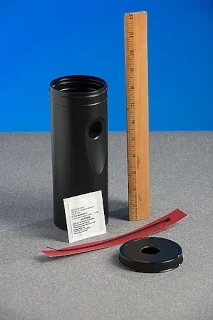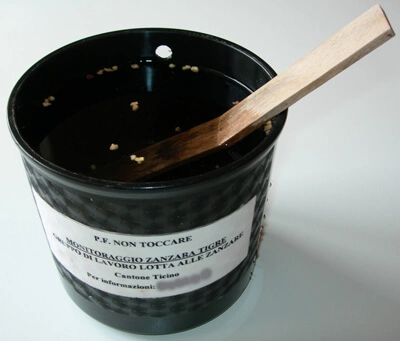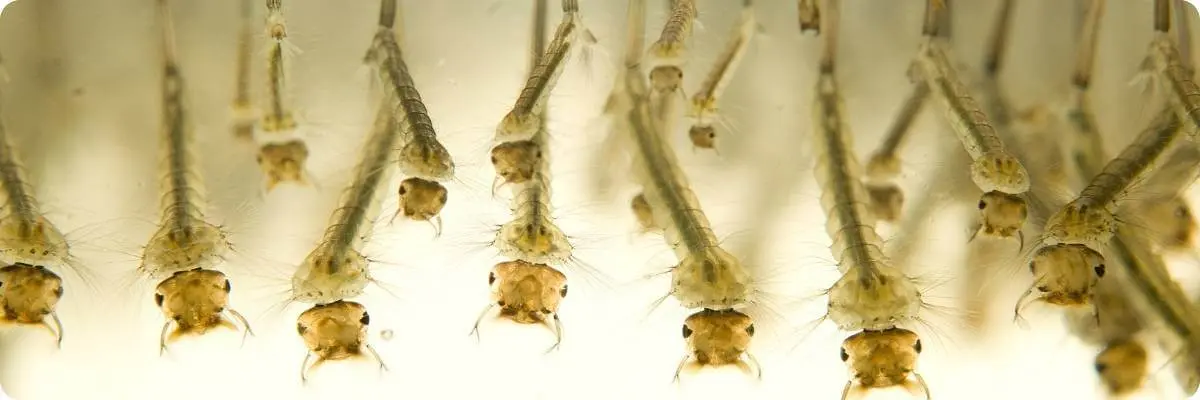Are you tired of mosquitoes ruining your summer?
Mosquitoes are a nuisance, and they’re more than just annoying. They can spread diseases like Zika, chikungunya, dengue, and yellow fever. The good news is that there’s something you can do about it!
Ovitraps are a great way of trapping and eliminating pregnant (gravid) mosquitoes. These traps will also prevent mosquito larvae from developing without using any harsh chemicals. You can buy or make these traps, and they can be a real help in keeping your yard free of mosquitoes. Check out this post to see how they work and how you can make your ovitraps.
What is an Ovitrap?
Ovitraps have been used for many years for detecting the presence of mosquitoes that use containers for breeding. A mosquito larvae trap is a cheap and passive trap.
An ovitrap mosquito trap is usually a black container aimed at stopping mosquitoes from reproducing. It attracts gravid (egg carrying) Aedes mosquitoes by mimicking the preferred breeding site of the Aedes albopictus (Asian tiger) and Aedes Aegypti (yellow fever) mosquitoes. They are often referred to as container breeding mosquitoes, and their eggs are laid on the walls of water-filled containers just above the waterline.
These mosquitoes are vectors for many diseases and have become resistant to some chemicals used in other control methods. Hence the need for other control methods like ovitraps.
They can be made out of various materials. But typically are a simple black plastic container with water in the bottom and some grass, leaves, or other organic matter that will create an infusion attractive to mosquitoes.
Passive Traps
One of the big advantages of using ovitraps is that they don’t need any electricity, CO2, chemicals, or other attractants.
You set them up and check them regularly to remove any debris that might block the entry. Empty the water weekly if there are any mosquito larvae or if you add a larvicide, such as Bti, to the water you will only need to change the water monthly. In dry, hot weather you may have to add water from time to time. You will have to replace any glue cards when they are full or don’t stick any longer.
How Does an Ovitrap Work?
An ovitrap is used as a breeding site for gravid Aedes mosquitoes. These mosquitoes are known to lay their eggs in natural or manmade containers. The ovitrap mimics these sites.
After biting a human or an animal, the female mosquito searches for a place to lay her eggs. She will look for an environment where the larvae can develop to give the next generation of mosquitoes.
If there are no or very few competing sites, she may lay her eggs in your trap. The eggs laid in the trap may produce larvae, but any resulting adult mosquitoes will not be able to escape from the trap. Additionally, the females laying the eggs may be trapped on sticky cards or killed by an insecticide, although this depends on the type of ovitrap.
Eliminate Competing Breeding Sites
For ovitraps to be successful, it is essential to eliminate other possible breeding sites in your yard and, if possible, in your neighborhood. Some examples of items that can hold water are children’s toys, tires, plastic sheets, birdbaths, pet bowls, yard art, buckets, gutters, plant saucers, and water-holding plants.
Different Ovitraps
There are several types of ovitraps, but they all work in very similar ways.
A Simple Homemade Ovitrap
The simplest form is a homemade trap that consists of a black container (the black trap color has been found to be more attractive for adult mosquitoes) with stagnant water and a fine metal mesh above the water. The eggs will pass through the mesh, but when the mosquitoes hatch and develop, they will be too big to escape.
Gravid Aedes Ovitrap or Autocidal Gravid Ovitrap
Other traps work slightly differently; they catch the adult female mosquitoes and stop the eggs from developing. Catching the adult mosquito has the advantage of stopping the mosquito from laying more eggs and will also stop any possible disease transmission.
A mosquito has decided to use your trap to lay her eggs; she will enter the trap and try to get near the water at the bottom of the trap to lay her eggs. The traps have a mesh that stops the mosquito from approaching the water and laying her eggs.
Unable to successfully lay her eggs, the mosquito will try to escape and be trapped on glue boards. If she does lay her eggs, either they won’t reach the water and hatch, or if they do fall through the mesh, the newly formed skeeters won’t be able to escape.
Lethal Ovitrap
There are also lethal ovitraps; they attract mosquitoes that successfully lay their eggs. The water contains substances, such as Bacillus thuringiensis israelensis, that will kill the larvae when they hatch. These are known as larvicidal ovitraps.
Another type of lethal ovitrap contains a pesticide to kill adult mosquitoes (adulticidal ovitraps). The sides of the container are too smooth for the gravid female to lay her eggs. So the female mosquito lays her eggs on a cloth, rough wood, or a paper strip at the surface of the water.
The egg-laying strip is treated with an insecticide. The female mosquito lays her eggs on the egg-laying strip and later dies. The eggs laid on the strip are also contaminated, and the larvae die.


How to Make a Mosquito Larvae Trap (Ovitrap)?
There are many models of ovitraps you could try, larvae traps or adult and larvae traps. The larvicidal trap above is particularly easy to make, although I prefer ovitraps that catch both newborn mosquitoes and adults. Here are a couple you could try.
Larvae Trap – a very simple and quick-to-make mosquito larvae killer.
Materials:
- a plastic bottle
- sandpaper
- netting – some old netting from a window screen or bag of potatoes. It needs to have a mesh size adult mosquitoes cannot pass through.
- rubber band
- scissors or craft knife
- black paper, paint, or fabric
- a few stones from the garden
- pond water, or rainwater
- grass, hay, or leaves
Making the Trap
- Cut the bottle in half with scissors or a craft knife.
- Use the sandpaper to rough up the part of the bottle near the cap, as the female mosquito needs a rough surface to lay her eggs.
- Using the elastic band put the netting over the mouth of the bottle. This will allow the eggs to drop into the water but the newly born adult mosquitoes won’t be able to get out.
- If you’re using rainwater add a few grass clippings and put a few stones in the bottom of the bottle, this will help to keep it stable in wind.
- Invert the top and tape it to the bottom of the bottle.
- Add the pond water or rainwater and fill it to just below the netting.
- Make a hole in the bottle just above the water level.
- The last step is to make the trap more attractive to mosquitoes by painting black paint, covering it with black tape or paper, or using black fabric. An easy way to do this is to stretch an old black sock over the trap.
- Now the trap has to be placed in a shaded area out of the wind. You can see a video explaining how to make the trap below
Autocidal Gravid Trap
In my opinion, this is a better trap to make (from colinpurrington.com) but involves a little more work. This is a trap similar to some of the commercial traps mentioned below that will trap adults and larvae. You can check out the instructions here.
Can You Buy an Ovitrap?
There are quite a few different ovitraps on the market. One of the best-known is the Biogents GAT (Gravid Aedes Trap) Trap but it is not the only model available. Others you could consider are the Catchmaster Ovi-Catch AGO (Autocidal Gravid Ovitrap) Mosquito Trap or the BioCare AGO Trap.
These traps work in a similar way, they attract the mosquitoes through color and an infusion attractive to mosquitoes. The mosquito enters the trap, can’t get to the water, due to a mesh screen, so tries to escape and she is caught on glue cards.
The only drawback for these traps is the price – $27 – $40. If you can convince your neighbors to join your battle against mosquitoes, ordering in bulk will save a few dollars on each trap.
You can find cheaper ovitraps such as the Up Trap, which uses a pesticide strip to kill mosquitoes, or the Dalen Products Skeet-O-Trap, which traps newborn mosquitoes. Both these traps cost about $15.
What Species of Mosquito Will Lay Eggs in an Ovitrap?
The most common mosquitoes that lay eggs in an ovitrap are Aedes aegypti and Aedes albopictus. In some areas, you may also catch a few Culex mosquitoes.
Where to Place Your Ovitrap for Maximum Effectiveness?
For best results, your ovitrap should be placed in a shady, humid, and wind-protected area. But as the black color is attractive to mosquitoes it should be visible and not hidden under bushes. You may have to try several different emplacements before you find the most successful.
Conclusion
If you have container-breeding Aedes mosquitoes in your vicinity, ovitraps are a great way of trapping and eliminating mosquito larvae without using any harsh chemicals. You can buy or make them. They are easy to use, and they can help reduce the number of mosquitoes all summer long!
If you want another trap that will catch more mosquitoes with different attractants read our mosquito trap buying guide.
However, one method of trapping mosquitoes won’t eliminate them. You should use ovitraps alongside other mosquito reduction methods: remove breeding sites, adult traps, adulticides (fogging), and larvicides. And as Aedes mosquitoes are also known to bite inside your house, screens on your windows and doors can protect you and some indoor mosquito traps will trap any skeeters that make it into your home.

